Venus
 One of the few things that Mercury and Venus have in common is that neither has a moon. Venus and Earth, on the other hand, have much in common. They have almost the same mass, the same diameter, and the same average density. Indeed, if Venus were located at the same distance from the Sun as is Earth, then it, too, might well have evolved life. However, Venus is 30% closer to the Sun than Earth, and this one difference between the two planets leads to a host of others, making Venus inhospitable to life.
One of the few things that Mercury and Venus have in common is that neither has a moon. Venus and Earth, on the other hand, have much in common. They have almost the same mass, the same diameter, and the same average density. Indeed, if Venus were located at the same distance from the Sun as is Earth, then it, too, might well have evolved life. However, Venus is 30% closer to the Sun than Earth, and this one difference between the two planets leads to a host of others, making Venus inhospitable to life.
7-5 The surface of Venus is completely hidden beneath a permanent cloud cover
At nearly twice the distance from the Sun as Mercury, Venus is often easy to view without interference from the Sun’s glare. At its greatest western elongation, Venus is seen high above the western horizon after sunset, where, like Mercury, it is often called the “evening star.” Conversely, high in the eastern sky before sunrise, it is called the “morning star.” The maximum elongation of Venus is always between 45° and 47°.
Venus is easy to identify because it is usually one of the brightest objects in the night sky. Only the Sun and the Moon outshine Venus at its greatest brilliance. Venus is often mistaken for a UFO (Figure 7-12), because when it is low on the horizon, its bright light is strongly refracted by Earth’s atmosphere, making it appear to rapidly change color and position. You can see the appearance of the inner planets using Starry Night™ (see also Guided Discovery: The Inner Solar System).

Unlike Mercury, Venus is intrinsically bright because it is completely surrounded by light-colored, highly reflective clouds (Figure 7-13). Because visible light telescopes cannot penetrate this thick, unbroken layer of clouds, we did not even know how fast Venus rotates until 1962. In the 1960s, however, both the United States and the former Soviet Union began sending probes there. The Americans sent fragile, lightweight spacecraft into orbit near the planet. The Soviets, who had more powerful rockets, sent more durable spacecraft directly into the Venusian atmosphere.
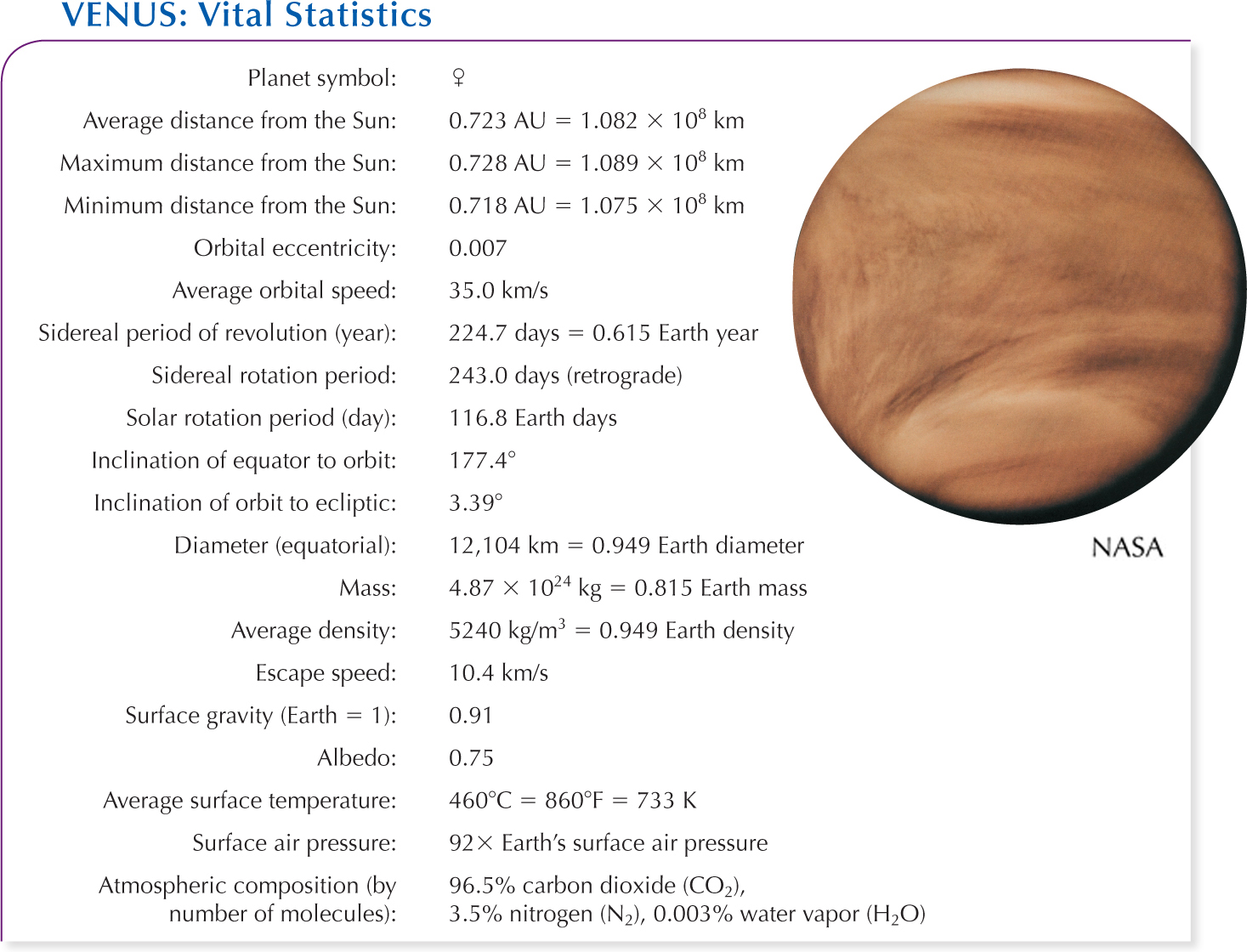
202
 Building spacecraft whose technology could survive the descent into Venus’s atmosphere proved to be more frustrating than anyone had expected. Finally, in 1970, the Soviet probe Venera (Russian for “Venus”) 7 managed to transmit data for 23 minutes directly from the Venusian surface. Soviet missions continued until 1985, measuring a surface temperature of 750 K (900°F) and a surface air pressure of 92 atm, among other things. This value is the same pressure you would feel if you were swimming 0.82 km (2700 ft) underwater on Earth.
Building spacecraft whose technology could survive the descent into Venus’s atmosphere proved to be more frustrating than anyone had expected. Finally, in 1970, the Soviet probe Venera (Russian for “Venus”) 7 managed to transmit data for 23 minutes directly from the Venusian surface. Soviet missions continued until 1985, measuring a surface temperature of 750 K (900°F) and a surface air pressure of 92 atm, among other things. This value is the same pressure you would feel if you were swimming 0.82 km (2700 ft) underwater on Earth.
In contrast to Earth’s present nitrogen- and oxygen-rich atmosphere (see Section 6-1), Venus’s thick atmosphere is 96% carbon dioxide, with the remaining 4% mostly nitrogen. This atmosphere is remarkably similar to Earth’s early carbon dioxide–rich atmosphere. These gases were vented from inside Venus through volcanoes and other openings. Unlike Earth, however, Venus has no liquid oceans to dissolve the carbon dioxide and no living organisms to convert it into oxygen and carbon compounds, so it remains in the atmosphere today.
Soviet spacecraft also discovered that Venus’s clouds are confined to a 20-km-thick layer located 48 to 68 km above the planet’s surface. Above and below the clouds are 20-km-thick layers of haze. Beneath the lower level of haze, the Venusian atmosphere is clear all the way down to the surface.
The results of the early probing of Venus’s atmosphere are summarized in Figure 7-14. Both pressure and temperature decrease smoothly with increasing altitude. From the changes in temperature and pressure above a planet’s surface, we can begin to understand the structure of its atmosphere.
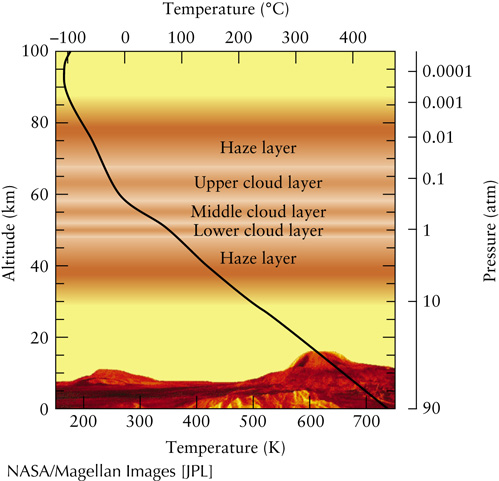
 Unlike the clouds on Earth, which appear white from above, the cloud tops of Venus appear yellowish or yellow-orange to the human eye. These colors are typical of sulfur and its compounds. Indeed, spacecraft found substantial amounts of sulfur dust in Venus’s upper atmosphere and sulfur dioxide and hydrogen sulfide at lower elevations. The clouds themselves are composed of droplets of concentrated sulfuric acid! Because of the tremendous atmospheric pressure at Venus’s surface, the droplets remain suspended as a thick mist, rather than falling as rain. Standing on the surface of Venus, you would experience a perpetually cloudy, yellow day (Figure 7-15).
Unlike the clouds on Earth, which appear white from above, the cloud tops of Venus appear yellowish or yellow-orange to the human eye. These colors are typical of sulfur and its compounds. Indeed, spacecraft found substantial amounts of sulfur dust in Venus’s upper atmosphere and sulfur dioxide and hydrogen sulfide at lower elevations. The clouds themselves are composed of droplets of concentrated sulfuric acid! Because of the tremendous atmospheric pressure at Venus’s surface, the droplets remain suspended as a thick mist, rather than falling as rain. Standing on the surface of Venus, you would experience a perpetually cloudy, yellow day (Figure 7-15).
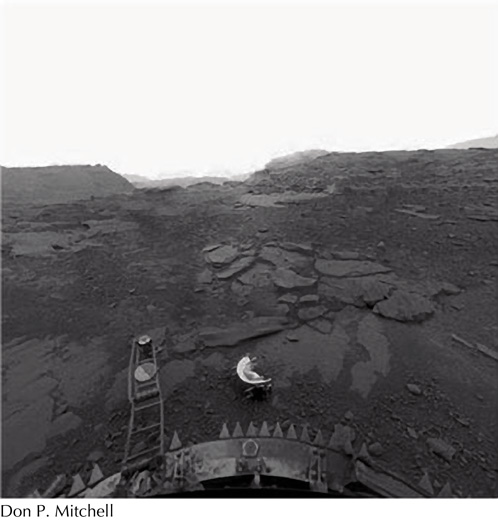
203
GUIDED DISCOVERY: The Inner Solar System
 Here we will learn more about the appearances of the inner planets as seen from Earth, using the Starry Night™ program.
Here we will learn more about the appearances of the inner planets as seen from Earth, using the Starry Night™ program.
Mercury
The first step is to see that Mercury is always close to the horizon when it is visible in the night sky. Click the Home button in the toolbar to move to your home location. Open the Find pane and remove any text from the search box at the top of the Find pane so that the list of solar system items is shown. Double-click the listing for Mercury to center this planet in the view.
- 1. If Mercury is below the horizon, the Mercury is not visible warning dialog will appear. In this case, click the Best Time button. If Mercury is to the west of the Sun (to the right if your location is in the northern hemisphere and the gaze direction is south, or to the left if your location is in the southern hemisphere and the gaze direction is toward the north), go to 2a. If Mercury is to the east of the Sun, go to 2b.
- 2a. If Mercury is already up in the sky, select View = Show Daylight or use the Daylight button in the buttonbar to be sure that the display of daylight is turned on. If Mercury is west of the Sun, we want to set up the view with Mercury as the “morning star.” To do this, click the Sunrise button in the toolbar and run time forward or backward at about 300× until Mercury is just above the eastern horizon and the Sun is below the horizon. This shows Mercury as the “morning star.” Now, run time forward and you will see the white dot of Mercury fade. (If Mercury is too close to the Sun, it will not be visible at all. In this case, change the date and try again.) Now go to section 3.
- 2b. If Mercury is east (to the left) of the Sun in the sky, then click the Sunset button in the toolbar. If necessary, select View = Show Daylight, or use the buttonbar to turn on the display of daylight in the view. Run the time forward or backward at about 300× until the Sun is about to set. Step forward in time by 1-minute intervals and watch Mercury first appear as the “evening star” and then set on the western horizon. (If Mercury is too close to the Sun, it will not be visible at all. If this is the case, change the date and try again.)
- 3. Now we explore Mercury’s orbit. Select Favourites = Explorations = Atlas and open the Find pane. Double-click the listing for Mercury to center this planet in the view. You may also wish to click the checkbox to the left of the listing for the Sun to label it in the view. Zoom in to about 70°. Set the Time Flow Rate to 6 hours (more or less, depending on your computer speed) and click the Play button. Describe and explain the motion of the Sun relative to Mercury. You can learn more about Mercury as seen from Earth by trying Observing Project question 47 at the end of the chapter.
Venus
Repeat the same procedures for Venus that were outlined above for Mercury, starting at step 1 above. What similarities and differences in the observed behavior of these planets do you see?
Mars
Select Favourites > Explorations > Atlas and set the date in the toolbar to February 23, 2010, and the time to midnight. Open the Find pane and double-click the listing for Mars to center this planet in the view. Click the checkbox to the left of the listing for the Sun in the Find pane to label it in the view. Now Zoom in on Mars until you see its surface features. What is the phase of Mars? Zoom out and use the hand tool or cursor keys to adjust the view so that both the Sun and Mars are visible on the screen. Use the angular separation tool to measure the angular distance between the Sun and Mars on this date. Does the Sun ever get this far in angle from Mercury or Venus, as seen from Earth? Explain.
Margin Question 7-4
Question
Why does the day have a yellow hue on Venus?
All of the major chemical compounds spewed into our air by Earth’s volcanoes have been detected in Venus’s atmosphere. Among these molecules are large quantities of sulfur compounds. Because many of these substances are very short-lived, they must be constantly replenished by new eruptions. In fact, the abundance of sulfur compounds in Venus’s atmosphere does vary. These data suggest the possibility that the sulfurous compounds in Venus’s atmosphere come from active volcanoes. This idea is supported by the discovery, in 2007, of lightning on Venus. Lightning has many sources in atmospheres, including active volcanoes, as seen here on Earth when the Eyjafjallajökull volcano erupted in 2010 in Iceland (Figure 7-16). The lightning on Venus, caused by the electrical discharges in the atmosphere, created short-lived magnetic fields that were detected by the Venus Express satellite.
204
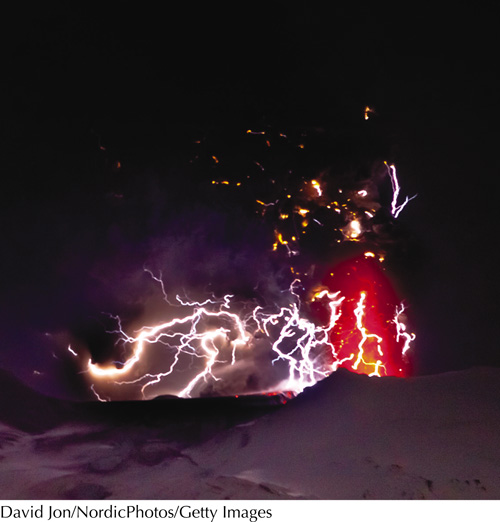
7-6 The greenhouse effect heats Venus’s surface
At first, no one could believe reports that the surface temperature on Venus was higher than the surface temperature on Mercury, which, after all, is closer to the Sun. Setting aside this initial skepticism, astronomers found a straightforward explanation—the greenhouse effect (Figure 7-17).

Carbon dioxide is responsible for the warming of Venus’s atmosphere. Like your car windows, carbon dioxide is transparent to visible light but absorbs infrared radiation. Although most of the visible sunlight striking the Venusian cloud tops is reflected back into space, enough light reaches the Venusian surface to heat it. The warmed surface, which is also heated from inside the planet, in turn, emits infrared radiation, which is absorbed by Venus’s carbon dioxide–rich atmosphere. Some of this trapped radiation returns to the planet’s surface, producing the high temperatures found there. The rest of the heat is radiated into space.
Without the greenhouse effect, the surface of Venus would have a noontime temperature of 465 K. But with the greenhouse effect, that temperature is actually a sweltering 750 K, hotter than the hottest spot on Mercury! Furthermore, the thick atmosphere keeps the night side of Venus at nearly the same temperature, unlike the night side of Mercury, where the temperature drops precipitously.
Margin Question 7-5
Question
Where on Earth (besides in a greenhouse) does the greenhouse effect occur?
This high temperature prevents liquid water from existing on Venus. Just like Earth, Venus was likely to have initially had water both in the debris from which it formed and from the impacts of ice-bearing bodies, such as comets. The high atmospheric temperature has evaporated any water that came to Venus’s surface, which is now bone dry. Today the total amount of water in Venus’s atmosphere would uniformly cover the planet to a depth of only 3 cm. The equivalent depth of a uniform ocean on Earth today would be 2.8 km (1.7 mi). In 2007, using the Venus Express spacecraft, astronomers determined from the chemistry of its present atmosphere that Venus once had at least 150 times as much water. The atmospheric heat has caused most of the water that was once in its air to drift to the top of the atmosphere, where ultraviolet radiation from the Sun split the water molecules into hydrogen and oxygen. The light hydrogen and some of the oxygen drifted into space, while much of the oxygen combined with other elements in the atmosphere and on the surface of the planet.
205
7-7 Venus is covered with gently rolling hills, two “continents,” and numerous volcanoes
Soviet spacecraft that landed on Venus provided us with intriguing close-up images of the planet’s arid surface. Figure 7-18 is a view of Venus’s regolith taken by Venera 13 in 1982. Russian scientists believe that this region was covered with a thin layer of lava that contracted and fractured upon cooling to create the rounded, interlocking shapes seen in the photographs. Indeed, measurements by several spacecraft indicate that Venusian rock is quite similar to lava rocks, called basalt, which are common on Earth and the Moon.
206

The entire Venusian surface was mapped by the Magellan spacecraft, which arrived at Venus in 1990. While in orbit about the planet, Magellan sent radar signals through the clouds surrounding Venus. Like radar used by police, some of the radar signals bounced off Venus and returned to the spacecraft. By measuring the time delay of the radar echo, scientists determined the heights and depths of Venus’s hills and valleys. As a result, astronomers have been able to construct a three-dimensional map of the planet. The detail (or resolution) visible on this map is about 75 m. You could see a football stadium on Venus if there were any. (None were detected.)
Venus is relatively flat compared to Earth. More than 80% of Venus’s surface is covered with volcanic plains and gently rolling hills created by numerous lava flows. Figure 7-19 is an image using the Magellan radar data to create a view of a Venusian landscape.
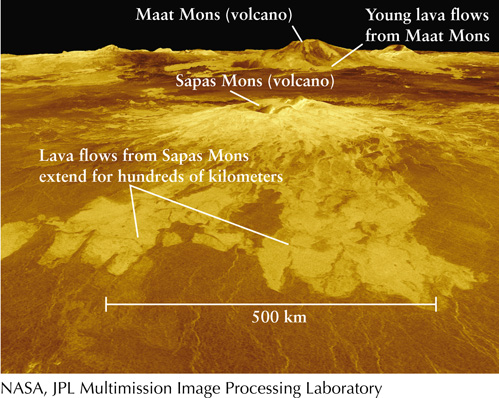
 RIVUXG A Venusian Landscape A computer combined radio images to yield this perspective view of Venus as you would see it from an altitude of 4 km (2.5 mi). The color results from light being filtered through Venus’s thick clouds. The brighter color of the extensive lava flows indicates that these flows reflect radio waves more strongly. The vertical scale has been exaggerated 10 times to show the gentle slopes of Sapas Mons and Maat Mons, volcanoes named for ancient Phoenician and Egyptian goddesses, respectively.
RIVUXG A Venusian Landscape A computer combined radio images to yield this perspective view of Venus as you would see it from an altitude of 4 km (2.5 mi). The color results from light being filtered through Venus’s thick clouds. The brighter color of the extensive lava flows indicates that these flows reflect radio waves more strongly. The vertical scale has been exaggerated 10 times to show the gentle slopes of Sapas Mons and Maat Mons, volcanoes named for ancient Phoenician and Egyptian goddesses, respectively.
Global radar images revealed just two large highlands, or “continents,” rising well above the generally level surface of the planet (Figure 7-20). The continent at high latitudes in the northern hemisphere is called Ishtar Terra (after the Babylonian goddess of love) and is approximately the same size as Australia. Ishtar Terra is dominated by a high plateau, Lakshmi Planum, ringed by towering mountains. The highest mountain is Maxwell Montes, whose summit rises to an altitude of 11 km (6.8 mi) above the average surface. For comparison, Mount Everest on Earth rises 9 km above sea level.
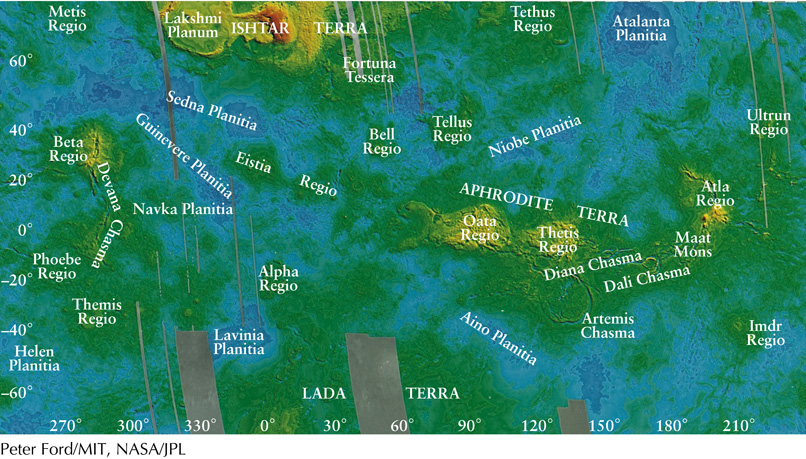
 RIVUXG A Map of Venus This false-color radar map of Venus, analogous to a topographic map of Earth, shows the large-scale surface features of the planet. The equator extends horizontally across the middle of the map. Color indicates elevation—red for highest, followed by orange, yellow, green, and blue for lowest. The planet’s highest mountain is Maxwell Montes on Ishtar Terra. Scorpion-shaped Aphrodite Terra, a continentlike highland, contains several spectacular volcanoes. Do not confuse the blue and green for oceans and land.
RIVUXG A Map of Venus This false-color radar map of Venus, analogous to a topographic map of Earth, shows the large-scale surface features of the planet. The equator extends horizontally across the middle of the map. Color indicates elevation—red for highest, followed by orange, yellow, green, and blue for lowest. The planet’s highest mountain is Maxwell Montes on Ishtar Terra. Scorpion-shaped Aphrodite Terra, a continentlike highland, contains several spectacular volcanoes. Do not confuse the blue and green for oceans and land.
The larger Venusian continent, Aphrodite Terra (named after the Greek counterpart of the Roman goddess Venus), is a belt of highlands that straddles the equator. Aphrodite Terra is 16,000 km (10,000 mi) in length and 2000 km (1200 mi) wide, giving it an area about one-half that of Africa. The global view of the surface of Venus in Figure 7-21 shows that most of Aphrodite Terra is covered by vast networks of faults and fractures.
207

 RIVUXG A “Global” View of Venus A computer using numerous Magellan images creates a simulated globe. Color is used to enhance small-scale structures. Extensive lava flows and lava plains cover about 80% of Venus’s relatively flat surface. The bright band running almost east-west is the continentlike highland region Aphrodite Terra.
RIVUXG A “Global” View of Venus A computer using numerous Magellan images creates a simulated globe. Color is used to enhance small-scale structures. Extensive lava flows and lava plains cover about 80% of Venus’s relatively flat surface. The bright band running almost east-west is the continentlike highland region Aphrodite Terra.
Radar images reveal that Venus has more than 1600 major volcanoes and volcanic features and fewer than a thousand impact craters (Figure 7-22), as compared to the hundreds of thousands of impact craters seen on the Moon and Mercury. Today, Venus’s thick atmosphere heats, and thereby vaporizes, much of the infalling debris that would otherwise create craters. Although pieces larger than around a kilometer in diameter would blast through even this thick atmosphere, most of the rubble entering Venus’s atmosphere is turned into dust by friction before it reaches the ground. However, there was most likely a period shortly after Venus formed and before its atmosphere developed (from gases escaping from the planet’s interior) when impacts and cratering were common.

If we accept that the young Venus was cratered like every other solid object in the solar system, we still need to explain the low number of craters on it today. Earth removes impact craters as a result of both weathering and tectonic plates drawing them into our planet. Neither of these effects is in play on Venus, which has typical wind speeds of less than 7 km/h (5 mph), no rain, and no large-scale tectonic plates like those that divide up and refresh Earth’s surface. Put another way, Venus is a one-plate planet.
Without weather or tectonic plates moving relative to each other, how can the craters be erased? Several mechanisms to explain this are being explored. Most theories posit that the lack of surface motion has forced Venus’s crust to become thicker than Earth’s crust. In one theory, heat from radioactive elements inside the planet causes mantle convection without tectonic plate motion. The temperatures inside the planet eventually become high enough in the regions of rising mantle to create massive volcanoes out of which pour enormous amounts of magma that cover large areas of the surface. A variation of this theory proposes that the thickening crust is suddenly thinned from below by the horizontal convective motion of the mantle, like stripping layers off of plywood. When so thinned, heat is able to rise through the crust and cause many volcanoes to form.
Margin Question 7-6
Question
Why does little cratering occur on Venus today, even compared to the present low rate of cratering on our Moon?
Another theory proposes that, episodically, the one-plate surface of Venus is heated enough from below to crack and begin Earthlike tectonic plate motion until it cools down and again becomes a single plate. During the period of plate motion, the surface is erased and replaced.
In yet another theory, the mantle becomes so hot that large sections of the crust melt more or less simultaneously, destroying the old crust and its craters. Indeed, that theory has been expanded to periodic global meltdowns occurring every 700 million years or so. For all of these models, when enough heat is released from the planet’s interior, its surface once again solidifies, and with the possible exception of local volcanic activity, the crust rethickens.
The sulfur content of the air and the traces of active volcanoes on the surface are compelling indicators that, like Earth, Venus has a molten interior. Because the average density of Venus is similar to that of Earth, its core is predominantly iron. Currents in the molten iron should generate a magnetic field; however, other than the transient magnetic field detected by Venus Express, none of the spacecraft sent to Venus has detected one. In general, magnetic fields are created by rotation of currents (see Section 6-4). Therefore, Venus’s apparent lack of a magnetic field is plausible only if it rotates exceptionally slowly. In fact, the planet takes 116.8 Earth days to get from one sunrise to the next (if you could see the Sun from Venus’s surface).
208
 That day is more unusual than just being much longer than ours. Unlike Earth and Mercury, Venus exhibits retrograde rotation, in which the direction of Venus’s orbit around the Sun (counterclockwise as seen from space far above Earth’s North Pole) is opposite the direction of its rotation (clockwise as seen from the same vantage point). In other words, sunrise on Venus occurs in the west and sunset in the east. Venus’s rotation axis is tilted more than 177°, compared to Earth’s 23½° tilt. Because Venus’s axis is within 3° of being perpendicular to the plane of its orbit around the Sun, the planet has no seasons. Although we do not know the cause of Venus’s retrograde rotation, one likely explanation is that a monumental impact flipped the rotation axis early in the planet’s existence.
That day is more unusual than just being much longer than ours. Unlike Earth and Mercury, Venus exhibits retrograde rotation, in which the direction of Venus’s orbit around the Sun (counterclockwise as seen from space far above Earth’s North Pole) is opposite the direction of its rotation (clockwise as seen from the same vantage point). In other words, sunrise on Venus occurs in the west and sunset in the east. Venus’s rotation axis is tilted more than 177°, compared to Earth’s 23½° tilt. Because Venus’s axis is within 3° of being perpendicular to the plane of its orbit around the Sun, the planet has no seasons. Although we do not know the cause of Venus’s retrograde rotation, one likely explanation is that a monumental impact flipped the rotation axis early in the planet’s existence.